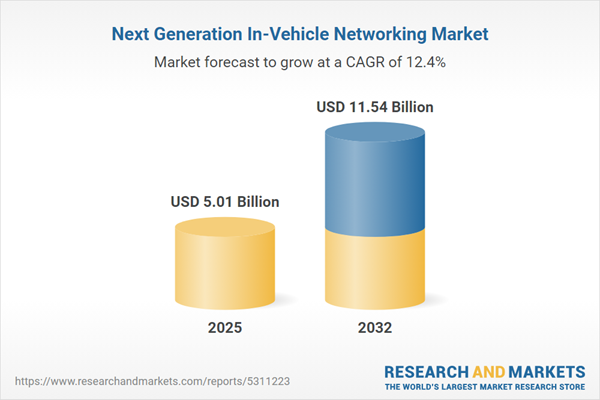Speak directly to the analyst to clarify any post sales queries you may have.
The Next Generation In-Vehicle Networking Market is evolving rapidly as automotive technologies advance, with in-vehicle connectivity, data management, and secure communication now central to vehicle innovation and industry competitiveness.
Market Snapshot: Next Generation In-Vehicle Networking Market Growth and Outlook
The global market for next generation in-vehicle networking increased from USD 4.52 billion in 2024 to USD 5.01 billion in 2025, with growth projected at a CAGR of 12.42%, reaching USD 11.54 billion by 2032.
This upward trend reflects rising demand for automotive-grade networking solutions that support real-time data exchange, high-definition infotainment, and advanced driver assistance systems. Industry innovation is also driven by electrification, vehicle autonomy, and evolving regulatory landscapes, motivating manufacturers and suppliers to reevaluate design, procurement, and production strategies as vehicle complexity grows.Scope & Segmentation: Coverage Across Technologies, Vehicles, Applications, and Regions
- Network Technologies: Controller Area Network, Ethernet, FlexRay, Local Interconnect Network, Media Oriented Systems Transport, Time-Sensitive Networking
- Connectivity: Wired Connectivity, Wireless Connectivity
- Vehicle Types: Heavy Commercial Vehicles, Light-Medium Commercial Vehicles, Passenger Cars
- Application: Advanced Driver Assistance Systems, Body Control & Comfort Systems, Infotainment, Powertrain Systems, Vehicle-to-Everything (V2X) Communication
- End User: Aftermarket, Original Equipment Manufacturers
- Geography: Americas (United States, Canada, Mexico, Brazil, Argentina, Chile, Colombia, Peru), Europe, Middle East & Africa (United Kingdom, Germany, France, Russia, Italy, Spain, Netherlands, Sweden, Poland, Switzerland, United Arab Emirates, Saudi Arabia, Qatar, Turkey, Israel, South Africa, Nigeria, Egypt, Kenya), Asia-Pacific (China, India, Japan, Australia, South Korea, Indonesia, Thailand, Malaysia, Singapore, Taiwan)
- Key Companies: ACOME, Analog Devices Inc., Astera Labs Inc., Broadcom Inc., Capgemini SE, Continental AG, Elmos Semiconductor SE, Hitachi Ltd., Hyundai Motor Company, Infineon Technologies AG, Intel Corporation, Keysight Technologies, LG Electronics Inc., Melexis NV, Microchip Technology Inc., NVIDIA Corporation, NXP Semiconductors N.V., Qualcomm Incorporated, Renault Group, Renesas Electronics Corporation, Robert Bosch GmbH, Samsung Electronics Co. Ltd, STMicroelectronics N.V., Tektronix Inc. by Fortive Corporation, Texas Instruments Incorporated, Toyota Motor Corporation, Visteon Corporation, Würth Elektronik GmbH & Co. KG, Xilinx Inc., Yazaki Corporation
Key Takeaways: Strategic Insights for Senior Decision-Makers
- Integrated domain controllers and centralized computing are redefining vehicle architectures, driving efficiency and future scalability.
- Time-Sensitive Networking and Ethernet adoption are enabling secure, high-speed communication for applications ranging from safety systems to digital cockpits.
- OEMs are rebalancing sourcing and procurement strategies, including diversification toward Southeast Asia and Eastern Europe to safeguard production and control costs.
- Cybersecurity and functional safety requirements are shaping network designs, compelling the deployment of resilient, adaptable protocols as standard practice.
- Collaboration between suppliers, chip manufacturers, and technology alliances is accelerating the validation and interoperability of new networking solutions, enhancing readiness for mass deployment.
Tariff Impact: Supply Chain and Cost Structure Adjustments
Recent tariff policies in the United States affecting electronic component and semiconductor imports have prompted global supply chain recalibration. Automotive OEMs and suppliers are initiating agreements that combine regional assembly with offshore manufacturing, leveraging transparency, digital tracking, and inventory strategies to mitigate risks from increased duties. These adjustments are strengthening the resilience of in-vehicle networking supply chains and reinforcing adaptable network designs that accommodate alternate component sources without performance losses.
Methodology & Data Sources
This report integrates secondary research—industry reports, technical standards, and regulatory reviews—with primary interviews of executives, engineering leaders, and procurement experts. Rigorous benchmarking and validation ensure insights are precise, relevant, and actionable for strategic planning.
Why This Report Matters
- Guides C-suite leadership in navigating technical and market disruption across global in-vehicle networking ecosystems.
- Supports procurement, product development, and partnership strategies that align with rapid advances in connectivity and regulatory landscapes.
- Equips decision-makers with actionable intelligence for supply chain management, compliance, and long-term innovation investments.
Conclusion
Adopting advanced in-vehicle networking frameworks is central for automotive industry success as electrification, autonomy, and digital functionality continue to expand. Strategic adaptation and cross-functional collaboration will position organizations to capture opportunities and address future mobility needs.
Additional Product Information:
- Purchase of this report includes 1 year online access with quarterly updates.
- This report can be updated on request. Please contact our Customer Experience team using the Ask a Question widget on our website.
Table of Contents
3. Executive Summary
4. Market Overview
7. Cumulative Impact of Artificial Intelligence 2025
Companies Mentioned
The companies profiled in this Next Generation In-Vehicle Networking market report include:- ACOME
- Analog Devices, Inc.
- Astera Labs, Inc.
- Broadcom Inc.
- Capgemini SE
- Continental AG
- Elmos Semiconductor SE
- Hitachi, Ltd.
- Hyundai Motor Company
- Infineon Technologies AG
- Intel Corporation
- Keysight Technologies
- LG Electronics Inc.
- Melexis NV
- Microchip Technology Inc.
- NVIDIA Corporation
- NXP Semiconductors N.V.
- Qualcomm Incorporated
- Renault Group
- Renesas Electronics Corporation
- Robert Bosch GmbH
- Samsung Electronics Co., Ltd
- STMicroelectronics N.V.
- Tektronix, Inc. by Fortive Corporation
- Texas Instruments Incorporated
- Toyota Motor Corporation
- Visteon Corporation
- Würth Elektronik GmbH & Co. KG
- Xilinx, Inc.
- Yazaki Corporation
Table Information
| Report Attribute | Details |
|---|---|
| No. of Pages | 186 |
| Published | November 2025 |
| Forecast Period | 2025 - 2032 |
| Estimated Market Value ( USD | $ 5.01 Billion |
| Forecasted Market Value ( USD | $ 11.54 Billion |
| Compound Annual Growth Rate | 12.4% |
| Regions Covered | Global |
| No. of Companies Mentioned | 31 |









